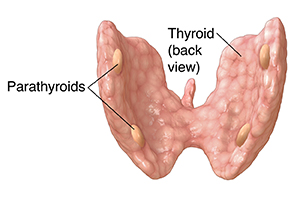A
B
C
D
E
F
G
H
I
J
K
L
M
N
O
P
Q
R
S
T
U
V
W
X
Y
Z
Click a letter to see a list of conditions beginning with that letter.
Click 'Topic Index' to return to the index for the current topic.
Click 'Library Index' to return to the listing of all topics.
Understanding the Parathyroid Glands
The parathyroid glands are 4 pea-sized glands in the neck. They sit behind the thyroid gland. Their main job is to keep the blood calcium level in a healthy range. This helps muscles and nerves work correctly. It also keeps bones strong. When there's a problem with the parathyroid glands, the blood calcium level may get too high or too low. These changes may affect the whole body.

How the parathyroid glands work
The parathyroid glands control the level of calcium and phosphorus in the blood by making parathyroid hormone (PTH). This is a chemical messenger that tells the body how to control calcium.
When blood calcium is low
When the blood calcium level is low, the glands make more PTH. This tells the body to increase the amount of calcium in the blood. To increase the blood calcium level, the body may absorb more calcium from food in the intestines. It may also take calcium from the bones and reabsorb more calcium from the urine.
When blood calcium is high
When the blood calcium level is high, the glands make less PTH. This tells the body to lower the amount of calcium in the blood. To lower the blood calcium level, less calcium is absorbed by the gut. Less calcium is taken from the bones. And more calcium is filtered out of the blood by the kidneys.
Online Medical Reviewer:
Marianne Fraser MSN RN
Online Medical Reviewer:
Raymond Kent Turley BSN MSN RN
Online Medical Reviewer:
Rita Sather RN
Date Last Reviewed:
4/1/2023
© 2000-2024 The StayWell Company, LLC. All rights reserved. This information is not intended as a substitute for professional medical care. Always follow your healthcare professional's instructions.